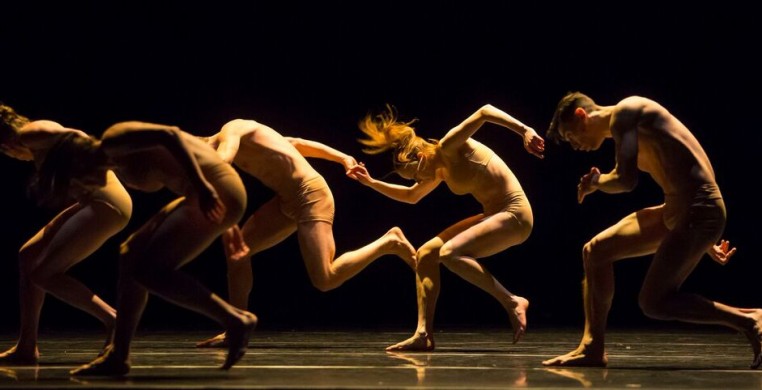Two massive ensemble works in Hubbard Street’s Spring Series, at the Harris Theater March 17-20, approach group identity from opposite vantage points, while a third chamber piece splits identities between two couples and uses an ensemble of men to amplify a solo character’s identity.
As different and uniquely thematic as each of the three works, each explores, teases, or wrestles with the use of the ensemble to portray collective identity.
In a brilliant stroke of choreographic metaphor, Gustavo Ramirez Sansano’s, “I am Mister B,” (2015) casts each individual dancer as Mr. B. At the same time, the entire ensemble of twelve takes on his collective identity, so that the whole of the work--music, movement, costuming, decor--becomes the embodiment of the one and only, inimitable man.
Every time I see “I am Mister B,” and this is my third go-round, I love it all over again and then some. I rally to Sansano’s infectious love affair with Tchaikovsky’s “Theme and Variations,” and to his loving homage to the mastery of his mentor, George Balanchine. It’s worth appreciating, once again, Sansano’s inspired enthusiasm for Balanchine’s innovative use of dancers as the visualization of the musical orchestration. Sansano’s choreographic energy extends to the decor as well, with rows of drapes parting, lifting, and closing in sync with the onrush of movement and the swell of musical phrases. The choreographer’s endless well of movement invention and his creative expansion of pantomimic gesture into abstract movement, along with Hubbard Street’s flawlessly bouyant execution, left me positively giddy with excitement.
In Lucas Crandall’s “Imprint” (world premiere) the ensemble is an anonymous, faceless mass, the antithesis of individual people, collectively everyman/woman and simultaneously no one. A dramatic slow-rising curtain creates a momentous beginning, gradually revealing the black silhouette of a faceless woman in high heels walking across the front of the stage. Soon, she is joined by others, identically-dressed in Branimira Invanova’s unisex hooded faceless masks and black bodysuits, women in high heels and men in oxfords. An occasional gesture of hands embracing the sides of their faceless heads has a tinge of fleeting anguish that erupts randomly in the brief pealing off of a mask, revealing the stark nakedness of a face, then quickly covering it back up. Set to Tàbor Radosti’s electronic score, we are transported into an eerie world of endless conformity where group mentality dictates a repetitive cycle of regimented walking and running circumscribing the periphery, bodies ignoring bodies, stepping over each other. One by one, they unmask, lift mouths upward like hungry fish gulping air, and come to sit at the edge of the stage. Here, Crandall transitions from the ominous to the comedic “Getting Down To The Nitty Gritty” in a pop song and dance interlude that sends the dancers down into the orchestra pit, only to re-emerge next to naked in flesh-toned skivvies and bare feet. Real human contact ensues, the world of touch and vulnerability to David Schultz’s live onstage drumming. A breakout explosion of agitated leaps and combative turns culminates in the curtain slowly lowering over a sacrificial figure lying Christ-like on the floor, his twitching hand the last vestige of life escaping the curtain. The individual victim of a world gone awry? “Imprint’s” opening and closing segments pair as justifiable opposites of each other--the conformity and regimentation of anonymity and the naked vulnerability of the individual exposed--but the comedic interlude that separates them makes for a puzzling disconnect. Dramatic as the staging, costuming and lighting may be, “Imprint” seems to posit familiar themes without cohesive enough development or nuanced enough movement to shed new light on old ideas.
In between the two is Hubbard Street resident choreographer Alejandro Cerrudo’s “The Impossible” (2014), dipping ever more deeply into dance drama that melds abstraction and narrative with surrealism. Cerrudo’s expanding movement vocabulary in “The Impossible” taps the emotional core of his characters while a simple set of a wall and a transforming mirror are used to stunning effect. Cerrudo pairs two couples, superbly danced by Ana Lopez and Andrew Murdock at the end of a lifetime together, and Jessica Tong and Jesse Bechard as the same couple at the start of their union. Both are flanked by the framing presence of Time/Mortality in the figure of the man in red socks and red suspenders, danced with commanding authority and flair by Florian Lochner. The two couples time travel in and out of each other’s past, morphing into each other’s present, merging, separating, and alternating as each other’s doppleganger. The tenderness of lifelong devotion, the brutality of loss and the reminiscence of youth and vitality have a dream-like transparency, heightened in an exquisite quartet in which the four dancers operate each other like interchangeable puppets and puppeteers. A men’s chorus effectively mirrors the man in red socks in a percussive sextet of bold, straight upward jumps, aggressively driving the woman to desperate measures to escape their torment. I don’t believe we are meant to derive literal meaning, and yet the presence of a gun that really goes “bang!” and streaks of blood on the mirror beg a story that the audience is left to write for itself, which may in fact be just what the choreographer ordered. It calls to mind a film by Jean Cocteau called “The Blood of A Poet,” where the specific image of a hand with a speaking mouth lingers long after the film is over. “The Impossible” has poetic reverberations that stick with you, too, like the mirror that unfolds off the wall to become a table, the couples capturing a moment of their past together as they dance on it, under it, and ultimately disappear into it. Cerrudo is emerging as a choreographer of unique vision and voice, bringing special distinction to Hubbard Street. As choreographer in residence, he has in Hubbard Street a magnificent canvas upon which to create and mature, and as audience, we reap the riches of both, a symbiotic triad of the first degree.

